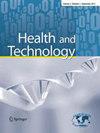使用特征选择选择肝功能异常的一致呼吸生物标志物:一项初步研究
IF 3.1
Q2 MEDICAL INFORMATICS
引用次数: 0
摘要
摘要目的近年来,呼吸谱分析作为一种非侵入性技术来识别各种疾病的生物标志物已经变得越来越重要。对个体异常肝功能进行呼吸谱分析,以识别呼出气体中的潜在生物标志物,可能是一种有用的诊断工具。本研究的目的是确定在不同生理状态下(包括休息和短暂锻炼)呼气中保持稳定和一致的潜在生物标志物,旨在开发一种检测肝功能异常的非侵入性诊断工具。方法采用气相色谱和质谱仪定量数据集进行分析。使用机器学习技术,包括特征选择和模型训练,对潜在生物标志物对模型性能的贡献进行排名和评估。采用统计学方法筛选具有显著性和一致性的生物标志物。最后选择的生物标志物使用机器学习算法迭代所有可能的组合,以确定其准确性范围。此外,使用分类模型来评估生物标志物的性能指标并比较模型。结果最终选择的生物标志物包括2-肉豆油酰基Pantetheine、Pterin-6 Carboxylic Acid、Methyl Mercaptan、N-Acetyl半胱氨酸和Butyric Acid,在不同的生理状态下呼出的气体中具有稳定的水平。检测肝功能异常具有较高的准确性和精密度。我们的机器学习模型在所有条件下的准确率范围为0.7至0.95,精度,召回率,预测概率和95%置信区间范围为0.84至0.94,使用这些生物标志物的各种组合。我们的统计和机器学习分析确定了有助于检测肝功能异常的重要和潜在的生物标志物。这些生物标志物在患者和健康组的身体不同生理状态中是一致的。使用呼吸样本和特征选择机器学习方法被证明是识别这些生物标志物的准确可靠的方法。我们的发现为该领域的未来研究提供了有价值的见解,并可以为肝病的非侵入性和成本效益诊断测试的发展提供信息。本文章由计算机程序翻译,如有差异,请以英文原文为准。
Selection of consistent breath biomarkers of abnormal liver function using feature selection: a pilot study
Abstract Purpose Breath profiling has gained importance in recent years as it is a non-invasive technique to identify biomarkers for various diseases. Breath profiling of abnormal liver function in individuals for identifying potential biomarkers in exhaled breath could be a useful diagnostic tool. The objective of this study was to identify potential biomarkers in exhaled breath that remain stable and consistent during different physiological states, including rest and brief workouts, intending to develop a non-invasive diagnostic tool for detecting abnormal liver function. Method Our study employed a gas chromatography and mass-spectrometer quantified dataset for analysis. Machine learning techniques, including feature selection and model training, were used to rank and evaluate potential biomarkers' contributions to the model's performance. Statistical methods were applied to filter significant and consistent biomarkers. The final selected biomarkers were iterated for all possible combinations using machine learning algorithms to determine their accuracy range. Furthermore, classification models were used to evaluate the performance metrics of the biomarkers and compare models. Result The final selected biomarkers, including 2-Myristynoyl Pantetheine, Pterin-6 Carboxylic Acid, Methyl Mercaptan, N-Acetyl Cysteine, and Butyric Acid, exhibited stable levels in exhaled breath during different physiological states. They showed high accuracy and precision in detecting abnormal liver function. Our machine learning models achieved an accuracy rate ranging from 0.7 to 0.95 in all conditions, with precision, recall, prediction probability, and a 95% confidence interval ranging from 0.84 to 0.94, using various combinations of these biomarkers. Conclusion Our statistical and machine learning analysis identified significant and potential biomarkers that contribute to the detection of abnormal liver function. These biomarkers were consistent across different physiological states of the body in both patient and healthy groups. The use of breath samples and feature selection machine learning methods proved to be an accurate and reliable approach for identifying these biomarkers. Our findings provide valuable insights for future research in this field and can inform the development of non-invasive and cost-effective diagnostic tests for liver disease.
求助全文
通过发布文献求助,成功后即可免费获取论文全文。
去求助
来源期刊

Health and Technology
MEDICAL INFORMATICS-
CiteScore
7.10
自引率
0.00%
发文量
83
期刊介绍:
Health and Technology is the first truly cross-disciplinary journal on issues related to health technologies addressing all professions relating to health, care and health technology.The journal constitutes an information platform connecting medical technology and informatics with the needs of care, health care professionals and patients. Thus, medical physicists and biomedical/clinical engineers are encouraged to write articles not only for their colleagues, but directed to all other groups of readers as well, and vice versa.By its nature, the journal presents and discusses hot subjects including but not limited to patient safety, patient empowerment, disease surveillance and management, e-health and issues concerning data security, privacy, reliability and management, data mining and knowledge exchange as well as health prevention. The journal also addresses the medical, financial, social, educational and safety aspects of health technologies as well as health technology assessment and management, including issues such security, efficacy, cost in comparison to the benefit, as well as social, legal and ethical implications.This journal is a communicative source for the health work force (physicians, nurses, medical physicists, clinical engineers, biomedical engineers, hospital engineers, etc.), the ministries of health, hospital management, self-employed doctors, health care providers and regulatory agencies, the medical technology industry, patients'' associations, universities (biomedical and clinical engineering, medical physics, medical informatics, biology, medicine and public health as well as health economics programs), research institutes and professional, scientific and technical organizations.Health and Technology is jointly published by Springer and the IUPESM (International Union for Physical and Engineering Sciences in Medicine) in cooperation with the World Health Organization.
 求助内容:
求助内容: 应助结果提醒方式:
应助结果提醒方式:


